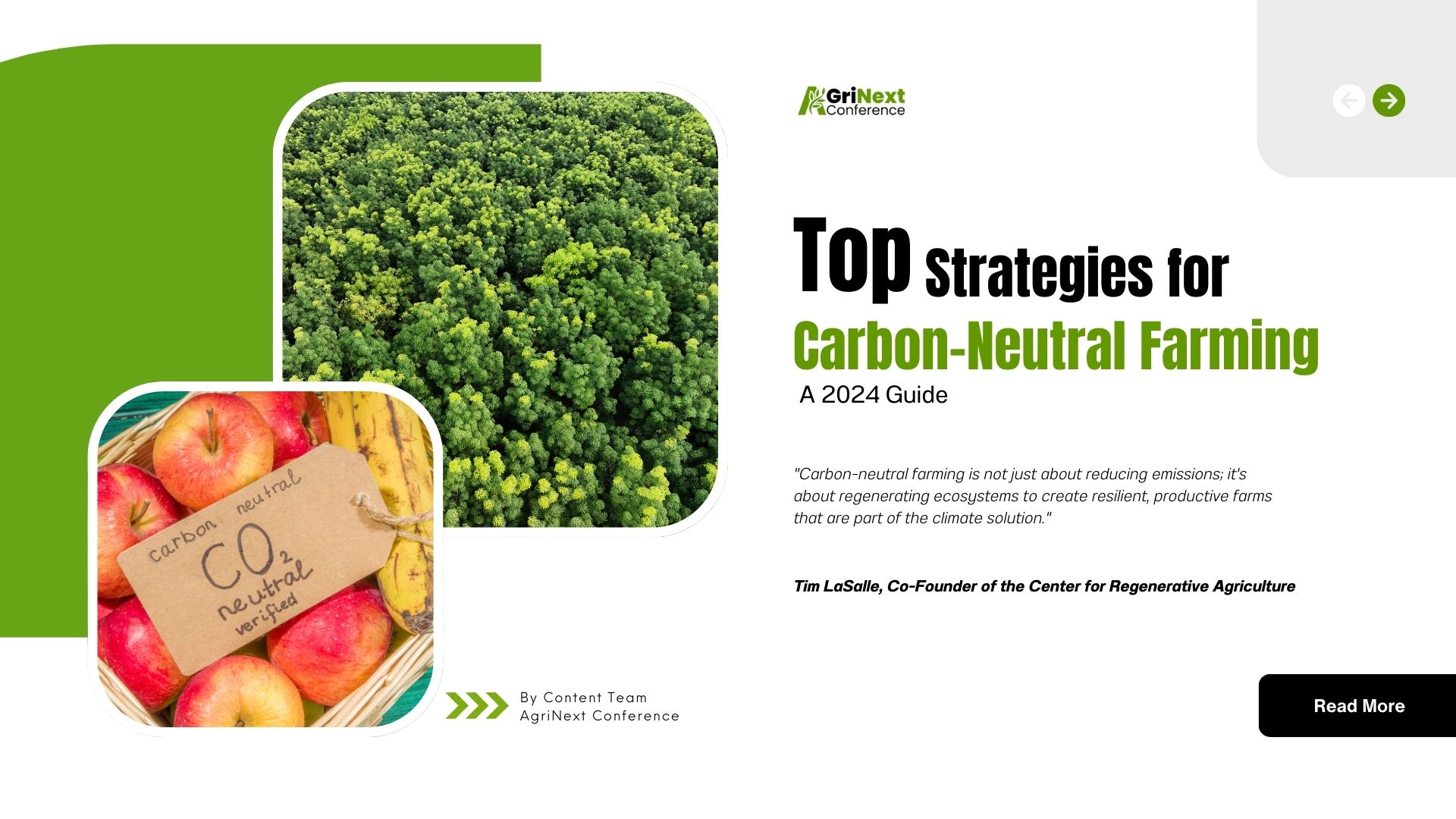
“Carbon-neutral farming is not just about reducing emissions; it’s about regenerating ecosystems to create resilient, productive farms that are part of the climate solution.”
Tim LaSalle, Co-Founder of the Center for Regenerative Agriculture
Introduction
As global temperatures rise, the agriculture sector faces increasing pressure to mitigate its carbon footprint, which accounts for approximately 24% of global greenhouse gas emissions. Carbon-neutral farming aims to balance carbon emissions with carbon sequestration, turning farming practices into part of the climate solution.
The inaugural European Carbon Farming Summit in March 2024, held in Valencia, Spain, gathered over 600 experts and organizations dedicated to advancing carbon farming and soil management. This event highlighted the growing commitment to sustainable agriculture.
As the importance of carbon-neutral farming becomes clearer, more farmers and organizations are adopting practices that promote environmental resilience and productivity. This article explores the importance of carbon-neutral farming and highlights top strategies to achieve it, contributing to a more sustainable future.
The Importance of Carbon-Neutral Farming for the Agriculture Sector
Carbon-neutral farming refers to agricultural practices that aim to balance the amount of carbon dioxide emitted during farming operations with the amount of carbon captured and stored, particularly in soil, trees, and plants. This balance is achieved through techniques such as sustainable soil management, agroforestry, and renewable energy use, which not only reduce emissions but also sequester carbon in ecosystems.
The agriculture sector plays a critical role in addressing climate change, as it accounts for significant greenhouse gas emissions – primarily through deforestation, livestock methane, and fertilizer-related nitrous oxide. Embracing carbon-neutral practices empowers farmers to fight climate change, improve soil health, enhance resilient farming systems, and secure food for the future.
Top Strategies for Achieving Carbon-neutral Farming
Sustainable Soil Management
Healthy soil is the cornerstone of carbon-neutral farming. It plays a critical role in storing carbon, filtering water, and supporting biodiversity. Key techniques like no-till farming, cover cropping, and crop rotation enhance soil health, sequester carbon, and reduce greenhouse gas emissions.
No-Till Farming: This practice avoids disturbing the soil, allowing it to retain organic matter that stores carbon over time.No-till farming can sequester up to 0.5 metric tons of carbon per hectare annually.
Cover Crops: Planting cover crops between growing seasons helps protect the soil, improve soil structure, and promote natural carbon sequestration
Crop Rotation: Rotating crops helps maintain soil fertility and reduces the need for chemical fertilizers, which can release harmful emissions.
Soil carbon sequestration not only contributes to carbon neutrality but also improves water retention and enhances overall farm productivity.
Rattan Lal, Soil Scientist and World Food Prize Laureate:
“Soil is the solution to climate change. By sequestering more carbon in soils, we can take a significant step toward mitigating the effects of global warming.”
Renewable Energy in Farming
The adoption of renewable energy sources is a major step towards reducing carbon emissions in farming operations. Solar panels, wind turbines, and bioenergy are increasingly being integrated into farming systems to replace fossil fuel use.
Solar and Wind Energy: Installing solar panels and wind turbines on farms helps generate clean energy, powering everything from irrigation systems to storage facilities.
Bioenergy: Some farms are converting organic waste into biogas, which can be used to power farm machinery and equipment.
Case Study: Iceland’s Sustainable Energy and Farming: A Model for the World
Sustainable energy integration in farming is gaining global attention as a solution to reduce carbon footprints. Iceland’s geothermal energy and Germany’s biogas innovations offer models of how carbon-neutral energy can be integrated into farming.
Friðheimar(Fridheimar) farm, located in Reykholt, Iceland, has seamlessly integrated renewable geothermal energy into all its operations. This enables them to grow tomatoes year-round, despite Iceland’s cold climate. Fridheimar also serves as a model for sustainable farming, utilizing renewable energy for both agriculture and tourism.
Another example is Juhnde Village in Germany, where the village farmers, including dairy farms, have implemented a biogas plant that converts organic waste such as manure and plant residues into energy. This biogas powers farming operations and heats local homes, drastically reducing the carbon footprint of agricultural activities.
These case studies showcase how renewable energy can be seamlessly integrated into farming, providing a model for other countries looking to reduce emissions while maintaining agricultural productivity.
Precision Agriculture Technologies
Precision agriculture is revolutionizing carbon-neutral farming by optimizing resource use.Utilizing drones, sensors, and satellite technology, farmers can monitor crops, soil, and water usage in real-time, reducing waste and improving efficiency.
Drones and Sensors
These tools help farmers target areas that need water or fertilizer, preventing excess use and minimizing the release of greenhouse gases.
Satellite Data
Satellites provide valuable data on soil conditions and plant health, helping farmers make informed decisions about land management.
By optimizing resources and reducing inputs, precision agriculture not only lowers emissions but also leads to cost savings in the long run. A recent study found that precision farming techniques reduced nitrogen fertilizer usage by 30%, significantly cutting emissions.
Agroforestry Practices
Agroforestry, the integration of trees and shrubs into farming systems, offers a powerful method for capturing and storing carbon. This practice not only sequesters carbon but also supports biodiversity, improves soil health, and protects crops from extreme weather.
Alley Cropping: Planting trees between rows of crops enhances carbon capture while providing shade, which can reduce water loss.
Silvopasture: Combining forestry and grazing allows for better livestock management while sequestering carbon in trees and soil.
Agroforestry is particularly effective in regions prone to desertification, helping restore degraded lands while reducing carbon emissions.
Case Study: The coffee plantations of Costa Rica.
Farmers integrate trees such as banana and timber species among coffee plants. This system provides shade, reduces soil erosion, and enhances biodiversity, which in turn improves the overall health and productivity of the coffee crop. The presence of trees also helps in pest control and offers additional sources of income from timber and fruit.
Mitigating Methane Emissions in Livestock Farming
Livestock farming is a major contributor to methane emissions, a potent greenhouse gas. However, innovations such as feed additives and rotational grazing are helping reduce methane output from livestock production.
Feed Additives: These additives alter the digestion process in livestock, reducing methane emissions during digestion. Studies show that methane emissions from livestock can be reduced by up to 30% with feed additives such as seaweed
Rotational Grazing: This practice improves pasture management by allowing land to recover, which can enhance carbon sequestration and reduce methane emissions.
Incorporating these techniques can significantly reduce the environmental impact of livestock farming, making it more sustainable.
Carbon Offsetting Programs
A carbon credit represents the reduction or removal of one metric ton of carbon dioxide or its equivalent. Farmers can sell these credits to companies looking to offset their emissions, generating additional revenue while supporting environmental sustainability.
Carbon Markets:
Farmers who adopt sustainable practices and sequester carbon can sell these credits on carbon markets, such as Verra and Gold Standard. These platforms offer verified carbon credits, allowing farmers to contribute to global climate goals while benefiting financially.
By participating in carbon offsetting programs, farmers are incentivized to implement eco-friendly practices, creating a win-win situation for both the environment and their financial bottom line.
Waste Management and Circular Farming
Efficient waste management is crucial for carbon-neutral farming. Circular farming turns waste into resources, reducing emissions and enhancing sustainability.
Composting: Organic farm waste, like crop residues and manure, is composted into nutrient-rich fertilizer, cutting the need for synthetic alternatives and lowering greenhouse gas emissions.
Biochar: Produced through pyrolysis, biochar locks carbon in the soil for centuries while boosting soil health and water retention.
Circular Systems: Livestock waste becomes fertilizer, and crop residues become animal feed, creating a closed-loop that minimizes waste and cuts carbon emissions.
This integrated approach helps farms reduce methane and achieve sustainability.
Policy Support and Government Initiatives
Governments worldwide are supporting carbon-neutral farming through financial aid, technical assistance, and carbon credit programs.
Subsidies for Renewable Energy: Many countries offer subsidies and tax incentives for renewable energy systems like solar and wind, as well as technologies promoting water conservation, waste management, and soil health, helping farmers adopt sustainable practices more easily.
Global Leadership in Carbon-Neutral Agriculture:
The European Union’s Green Deal is a prime example of how policy can drive sustainable farming. With its goal to cut emissions and promote biodiversity, it offers funding and regulatory support to encourage farmers to adopt carbon-neutral practices.
USDA programs provide similar support for regenerative and carbon-neutral farming techniques.
News and Updates
Kerala’s Carbon-Neutral Farming Initiative
The Indian state of Kerala has launched a carbon-neutral farming initiative, with the goal of becoming the first state to implement carbon-neutral farming methods. The government has allocated ₹6 crore in the 2022-23 Budget for this initiative.
Kerala’s carbon-neutral initiative shows how regional governments are taking proactive steps to integrate carbon-neutral methods, potentially serving as models for other states.
A village in Kerala, India, has launched a tree banking scheme to become carbon-neutral by 2025. Farmers are paid to plant and look after trees, which helps to absorb carbon dioxide from the atmosphere.
Carbon-Smart Farming
Carbon-smart farming practices, such as reducing tillage and planting cover crops, can help to increase the amount of carbon stored in soil. This approach can also improve soil health and reduce erosion.
Carbon Neutral Agriculture Course
The University of Melbourne is offering a short course on carbon-neutral agriculture, which covers topics such as carbon auditing, offset methods, and reducing farm emissions.
Bayer has launched a carbon initiative to help farmers adopt climate-smart practices. The initiative provides assistance and rewards for farmers who adopt these practices.
India has announced its goal of achieving net-zero emissions by 2070. The country plans to reduce its carbon intensity by 45% by 2030 and reduce one billion tonnes of carbon by 2030.
These government initiatives play a crucial role in scaling carbon-neutral farming, ensuring that farmers have the resources they need to implement sustainable practices while contributing to global climate goals.
Success Story: Sikkim’s Organic and Carbon-Neutral Journey
Sikkim, a small Indian state, became the world’s first fully organic state in 2016. By eliminating chemical fertilizers and pesticides, the state also took significant steps toward carbon-neutral farming. Organic farming practices, like using compost and natural pest control, have reduced carbon emissions and improved soil health.
The state’s efforts have also boosted local biodiversity and attracted eco-tourism, providing additional income for farmers. Sikkim’s success showcases how shifting to sustainable agricultural practices can simultaneously benefit the environment and the economy.
Conclusion
Carbon-neutral farming is not just a trend but a necessity for the future of agriculture. By adopting these strategies, farmers can significantly reduce their carbon footprint and contribute to global climate goals. In 2024, these practices are more critical than ever, ensuring that agriculture can meet the needs of a growing population while safeguarding the planet for future generations.
As we look ahead, platforms like AgriNext Awards,Conference & Expo 2024 are driving the conversation on carbon-neutral farming by showcasing innovations and sustainable practices.
The event brings together global experts, startups, and thought leaders who are shaping the future of agriculture through technology, sustainability, and regenerative methods. AgriNext offers a vital space for farmers and agricultural professionals to explore these top strategies, ensuring a more resilient and sustainable future for the industry.
Signup For AgriNext Conference Newsletter


